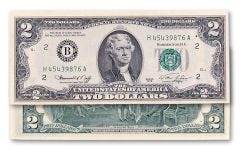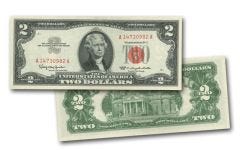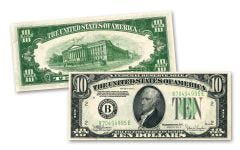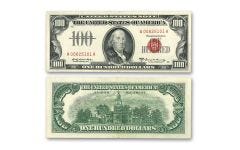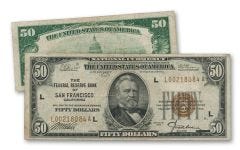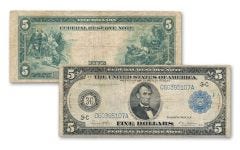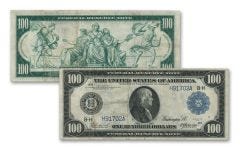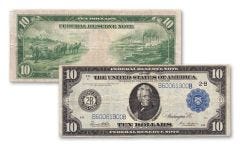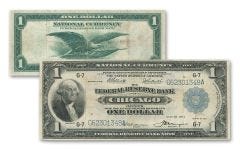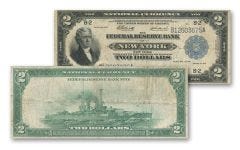Local Storage seems to be disabled in your browser.
For the best experience on our site, be sure to turn on Local Storage in your browser.
Federal Reserve Notes
In 1907, the United States experienced a banking panic. Runs on banks and trusts took place throughout the country due to a loss of faith in the institutions, many of which went bankrupt. In the wake of the crisis, a commission was created to get to the bottom of what caused the crisis and propose solutions to prevent future such crises. One of the outcomes of that undertaking was the creation of the Federal Reserve Bank in 1913. The Federal Reserve began printing notes that would serve as United States paper currency. Today, Americans regularly use U.S Federal Reserve notes in daily commerce, although certain historic and special issue notes are collected just like coins. GovMint.com has these notes available for our customers. Scroll below for more information on Federal Reverse Notes and find the perfect fit for your collection.
-
1976 Series 2 Dollar Federal Reserve Note CU
$11.95 As Low As $11.60- Qty Credit Card Wire
- 1+ $11.95 $11.60
In Stock -
1953-1963 2 Dollar Legal Tender Note VF
$11.95 As Low As $11.60- Qty Credit Card Wire
- 1+ $11.95 $11.60
In Stock -
1934 $10 Federal Reserve Note Green Seal Circulated
$57.95 As Low As $56.24- Qty Credit Card Wire
- 1+ $57.95 $56.24
In Stock -
-
1929 Series $50 Federal Reserve National Bank Note Fine
- Qty Credit Card Wire
- 1+ $286.95 $278.48
In Stock -
-
-
-
-
1918 $1 Defiant Eagle Federal Reserve Note Fine
- Qty Credit Card Wire
- 1+ $454.95 $441.53
Available for Order -
-
1918 2 Dollar Federal Reserve Bank Note Battleship Fine
- Qty Credit Card Wire
- 1+ $1,195.00 $1,159.75
In Stock
Year of the Dog Federal Reserve Note
2018 was the Year of the Dog in the Chinese, lunar calendar. In that year, $2 Series 2013 federal reserve notes were issued. They featured President Thomas Jefferson on the obverse and a painting known as “The Declaration of Independence” on the reverse. Experts sorted through these notes by hand to find those with serial numbers that ended in “88.” This is significant because the number 8 is lucky in Chinese culture.
Hawaii Federal Reserve Notes
December 7, 1941 was one of the darkest days in American history. Japan attacked Pearl Harbor in a sneak attack that brought the United States into the Second World War. The United States became concerned about the possibility of the Japanese invading the islands and, in doing so, take the US currency that was in circulation there. In response, the United States printed overprinted notes with the word “HAWAII” for issue on the islands. The notes would be deemed worthless if the Japanese invaded. Few of these notes survive today, but GovMint.com sometimes has some available for our customers. They are fascinating conversation pieces that connect holders to one of the most significant events of the 20th century.
1929 Banknotes
The 1929 stock market crash sent the United States into the Great Depression. The start of it was not the worst part, though, as the hoarding of cash and lack of confidence in banks made the situation worse. In 1933, President Franklin Roosevelt closed the banks for three days to stop a panic, and the Federal Reserve Banks were permitted to issue as many notes as they deemed necessary. Some of these notes are currently available from GovMint.com

